New Twists in Earth's Radiation Belts
By Daniel Baker
Rings of high-energy particles encircling our planet change more than researchers realized. Those variations could amplify damage from solar storms.
Rings of high-energy particles encircling our planet change more than researchers realized. Those variations could amplify damage from solar storms.

DOI: 10.1511/2014.110.374
Late in the evening of January 31, 1958, a 32-ton Juno I rocket blasted
into space from Cape Canaveral, Florida, lofting the Explorer I
spacecraft into orbit. It was a mission of firsts: Explorer I was the
first U.S. satellite (joining Sputnik 2, which had been launched the
previous November by the Soviet Union).
The satellite carried a pioneering scientific payload, prepared at the State University of Iowa by a team of researchers led by James A. Van Allen. And the instruments on Explorer I made the first revolutionary discovery of the Space Age: Earth is enshrouded in doughnut-shaped rings, or toroids, of high-energy, high-intensity radiation.
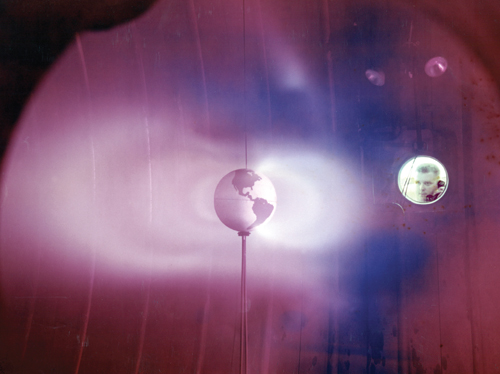
Image courtesy of NASA.
The discovery of those radiation belts—now called the Van Allen belts—revealed how Earth’s magnetic field interacts with the space environment around it. The field, generated by Earth’s molten metallic core and planetary spin, creates the magnetosphere, a magnetic bubble surrounding the planet; the size and shape of the magnetosphere change in response to the blowing of the solar wind, the constant stream of charged particles flowing from the Sun. The magnetosphere is crucial to life on Earth; it shields the atmosphere, as well as life on the surface, from damage by the solar wind and by even more energetic cosmic rays. But close in, Earth’s magnetic field lines trap and accelerate free-floating particles, largely protons and electrons, and bounce them back and forth between the poles of the planet. Those zones of trapped, agitated particles make up the Van Allen belts that Explorer I flew through. It was discovered that the belts took the form of two concentric rings: The inner belt extends from an altitude of about 1,000 to 6,000 kilometers above Earth, whereas the outer belt spans from about 13,000 to 60,000 kilometers.
Earth’s Van Allen belts are imperfect shields, however. High-speed particles can leak from the belts and collide with molecules in the atmosphere, giving rise to aurora displays. If there is a major magnetic eruption on the Sun, the resulting outrush of particles may break through the outer magnetosphere and overload the Van Allen belts in more destructive ways. The rapid injection of particles into the belts can damage the circuitry and solar panels on satellites in orbit; swarms of protons and electrons released when solar wind particles crash into the atmosphere induce electrical currents that can overload terrestrial power systems and cause blackouts.
Almost exactly a century preceding the Explorer I launch, on the night of August 28 to 29, 1859, people around the world got to witness what happens when an enormous solar storm overwhelms Earth’s magnetosphere. The New York Times reported that thousands of New Yorkers watched “the heavens…arrayed in a drapery more gorgeous than they have been for years.” An even more spectacular aurora display occurred on September 2, when the sky lit up as far south as Central America in the Northern Hemisphere. Disturbances in Earth’s magnetic field were so powerful that magnetometer readings were driven off their scales. Telegraph networks were unusable for nearly eight hours in most parts of the world due to high-energy particles in the atmosphere. In several regions, operators reported that their telegraphs were sparking from the electrical current induced by the aurora. Earth had experienced a one-two punch of solar storms the likes of which have not been recorded since.
Humanity was just beginning to develop electrical technology in 1859. There were no high-power electrical lines crisscrossing the continents, nor were there sensitive satellites orbiting Earth. In 1989, just before the rise of the Internet and GPS systems, a smaller but still potent solar storm demonstrated the heightened risk. The 1989 storm induced huge ground currents that knocked out Quebec’s electrical power grid and caused problems at 200 sites in the United States, particularly in regions situated on igneous rock because it resists conduction and therefore flows current into nearby wires. If another solar event like the one in 1989 happened today it could disrupt global communications, causing chaos for days. Another 1859-style superstorm could knock out some power grids and communications networks for weeks or more.
Our Sun operates on an 11-year cycle of activity, and today it is near the maximum of that pattern, meaning it could at any time produce large-scale events. In mid-July 2012, a solar storm of immense power narrowly missed the Earth; had it happened a week earlier, the planet might have been in the direct path of the blast. My colleagues and I are vigorously pursuing studies of space storms and the changes in our near-Earth space environment, which we lump under the term space weather. There is a pressing need for our technological society to understand in ever better detail the workings of the space environment around us. A clearer picture of the dynamics of the Van Allen belts is one important piece of this puzzle.
What happens to satellites during space storms is of great practical importance. After the pioneering work of Van Allen and his coworkers in the United States, along with their counterparts in the Soviet Union, there was an explosion of interest in the use of space for human needs. Over just a few years in the late 1950s and early 1960s, space hardware went from technological demonstration and scientific curiosity to full-fledged societal imperatives. Earth satellites were launched into space to meet needs for communication, navigation, weather observations, remote Earth sensing, and military reconnaissance. Today the Earth is circled by spacecraft from just above our atmosphere to distances of tens of thousands of kilometers above Earth’s surface. It would be almost inconceivable to try to imagine our modern U.S. society without the capabilities provided by spacecraft systems. But any of the many hundreds of spacecraft operating in Earth orbits today can be damaged by space radiation if the circumstances are right. In 2003, 46 of the 70 satellite failures reported that year occurred during a geomagnetic storm in October.
When high-energy protons and other ions hit orbiting spacecraft, they often leave ionization tracks in electronic chips. These tracks can upset spacecraft computer memories and otherwise disrupt sensitive electronics. As a result, satellite solar power panels may be damaged, optical tracker systems may become confused, and spacecraft command-and-control software may be scrambled. High-energy protons and ions may also injure, and potentially kill, astronauts who are in space during a major solar particle event. Manned launches have had to be rescheduled as a result, a major obstacle to long missions such as ones that might go to Mars. The high-energy protons in the inner Van Allen zone are especially a continuing risk to satellites and humans alike.
Energetic electrons in the space environment can also be devastating to spacecraft. They can readily penetrate even thick spacecraft shielding and bury themselves in insulating materials, such as coaxial cables or electronics boards, deep within spacecraft systems. As charge builds up in the insulating materials, a powerful internal electrical discharge can occur, much like a miniature lightning strike. Numerous recent spacecraft failures have been attributed to this mechanism.
Another space weather effect is known as surface charging. Lower energy electrons cannot penetrate the shielding but can accumulate on insulating satellite surfaces. As with interior insulators, charge buildup on the surface may lead to a powerful, disruptive discharge, generating electrical signals in the spacecraft’s vicinity that can scramble and disorient the satellite and its subsystems.
In light of the world’s dependence on Earth-orbiting platforms, it must be realized that every one of these spacecraft fly through—essentially continuously—the high-energy radiation environment that Van Allen’s group discovered over five decades ago. Thus, one of the most enduring and persistent aspects of space weather is the hostile radiation belts girding the Earth. Probes have returned data showing that the Van Allen belts wax and wane in intensity, depending on both local conditions and Sun activity. Even 50-plus years after their discovery, we still need a deeper and more insightful comprehension of the Van Allen belts’ behavior.
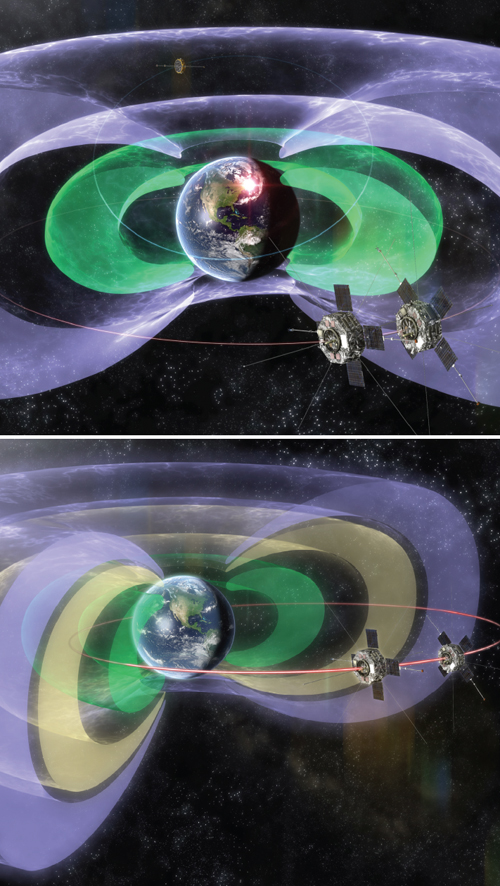
Illustrations courtesy of Dr. Andy Kale, University of Alberta.
About a decade ago, NASA began developing a program called Living With a Star. This program name acknowledges that we on Earth live in the outer atmosphere of a magnetically active star—our Sun—that exerts a huge influence over all aspects of the environment on our planet. We rely on the Sun for heat and light, of course, but we also must endure the fits of temper that it exhibits when it releases huge x-ray emissions in a powerful solar flare, or when it erupts 10 billion tons of hot plasma at several million miles per hour in dramatic expulsions we call coronal mass ejections. These immense solar storms can, in turn, pump up the Van Allen belts to an extraordinary degree, making the radiation zones around Earth immensely more dangerous for days or even weeks on end.
The Living With a Star spacecraft program got under way on February 11, 2010, with the launch of the Solar Dynamics Observatory. This spacecraft has been returning huge volumes of data about the Sun and the outer solar atmosphere called the corona, as well as images of the Sun that are truly breathtaking in their beauty and detail (see Sightings, July–August 2014).
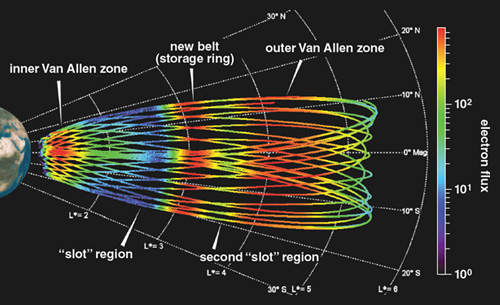
Image courtesy of the author.
The second wave of the program, dubbed the Radiation Belt Storm Probes project and later renamed the Van Allen Probes, was geared toward studying the Van Allen radiation belts in all their complexity and variability. The aim of this mission was to launch two identical Earth-orbiting spacecraft that fly in large elliptical, equatorial orbits that would carry them all the way through both the inner and outer Van Allen belts. With comprehensive measurement capabilities in each of the twin spacecraft, the multiyear mission would examine the Van Allen belt regions at a level of detail never before seen. The satellites were launched on August 30, 2012.
After most NASA spacecraft launches, experiment teams wait patiently for several months as research instruments on board are turned on one at a time, slowly ramped up to full power, and generally tested to make sure they work at full capacity. That was the plan for the Van Allen Probes as well. Our research team, however, urged that our instrument, the Relativistic Electron-Proton Telescope (REPT), be turned on just three days after launch. The reason for our haste was that another Sun-monitoring satellite called SAMPEX (Solar, Anomalous, and Magnetospheric Particle Explorer) was about to re-enter Earth’s atmosphere and be destroyed. We wanted the instruments on the two missions to overlap so that we would have continuous, calibrated data. NASA agreed to our request.
It was a lucky decision. On August 31, just before REPT turned on, a long filament of solar plasma erupted out into space, sending a powerful solar coronal disturbance toward Earth. When that storm started to reach Earth a day later it hit the radiation belts and caused them to change dramatically. To the great satisfaction of our team, the REPT instruments worked well from the moment they were turned on, on September 1. REPT observed freshly accelerated particles trapped in the belts, and recorded their high energies as the belts increased in size and strength.
Then something happened that no one had ever reported before: The particles settled into a new configuration, showing an extra, third belt between the two known belts. Within mere days of launch, the RBSP spacecraft showed us something that would require rewriting textbooks about how the Van Allen belts can be configured. The third belt was dubbed the storage ring in our publications.
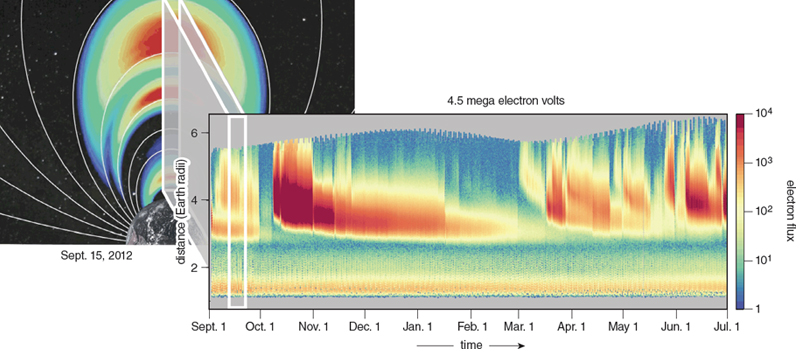
Images courtesy of the author.
Our team uses color coding of particle intensities to demonstrate how the radiation belts changed in time and space over the first full year of operation. As shown to the right, this long-term summary features fascinating examples of abrupt onset of electron acceleration, long periods of gradual inward radial transport of energetic particles, and striking examples of abrupt electron losses. The three-belt radiation zone structure from September 2012 is visible, as is the return of this remarkable feature in March 2013.
In their first two years in orbit, the instruments on the Van Allen Probes have worked exceptionally well, and our science teams are excited about a flood of observations coming to us with unprecedented clarity and quality. This is the first time we have been able to gather such a complete set of data about the belts, with the added bonus of watching from two separate spacecraft that can better show how events sweep across the area in time. Spotting something new in space, such as the third radiation belt, has more implications than the simple knowledge that such a feature is possible—for instance, it shows that extremely high-energy particles can appear and disappear almost in the blink of an eye. In a region of space that remains so mysterious, any observations that link certain causes to specific effects adds another crucial piece of information to the long-standing puzzle of what drives these belts.
The two Van Allen Probes recorded a nearly 1,000-fold jump in electron density in less than 12 hours.
The probes have also filled in details about the inner workings of the Van Allen belts that had previously been merely speculative. For several years after the 1958 discoveries of Van Allen and his coworkers, researchers theorized that the radiation belt electrons come from the distant reaches of Earth’s magnetosphere. Theorists proposed that as the particles drifted closer to Earth and encountered stronger magnetic fields, electrons would be accelerated and would form into a ringlike configuration. But this type of acceleration process would take days to weeks and best describes radiation belts that vary only gradually over time.
In the 1990s, satellites such as SAMPEX began to reveal that the energy and densit
y of the Van Allen belts changed much more quickly. Consequently, a competing theory for the origin of the belts’ electrons began to take hold: It was suggested that charged particles do not come from far out in the system, but are produced locally within the heart of the outer belt. This would occur when electric fields within the belts take low-energy electrons, which are ever present in all regions of space, and accelerate them to nearly the speed of light. This process could alter the density and energy of the belts on scales of seconds to hours, a theory that matched better with the observations from the 1990s.
Unfortunately, older satellite observations were too sparse in spatial coverage and the spacecraft were not designed to measure rapidly changing properties of the belts at different locations, as would be needed to fully distinguish between the two proposed acceleration mechanisms. Those data shortcomings changed drastically with the launch of the Van Allen Probes. In early October 2012, a week after a solar storm had swept the outermost Van Allen belt of virtually all of its high-energy electrons, the two probes recorded a nearly 1,000-fold jump in electron density in less than 12 hours (as shown in the figure below). The twin set of spacecraft observations clinched the case for electric fields deep within the belt accelerating the electrons.
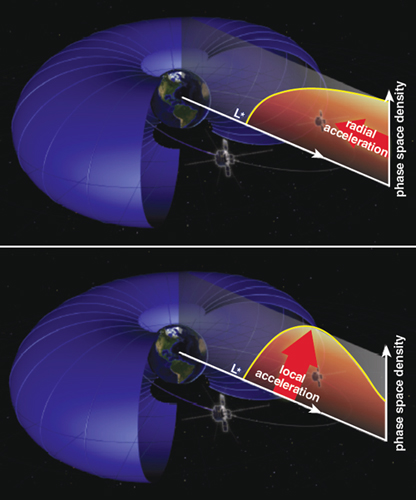
Illustration courtesy of NASA/ G. Reeves/M. Henderson.
But research my colleagues and I published in early 2014 showed that the outer radiation belt developed at different time scales: Particles would be lost from the belt by a gradual inward diffusion, over a period of months, and then would be replenished rapidly by strong solar wind events. Therefore several mechanisms of electron energization are in play in the belts, often acting almost concurrently or at least in rapid succession.
We have, with the Van Allen Probes October 2012 event, been able to readily distinguish between the different ways that particles can be accelerated. In this way, the Van Allen Probes have seen right to the heart of the magnetospheric acceleration process. The measurements clearly show that substantial particle acceleration can occur locally in the core of the outer radiation zone. This work shows that the frequency of some of the electromagnetic waves in the belt matches the frequency at which electrons travel around the local magnetic field, a synchrony that makes it easy to pump up the charged particles.
My colleagues at the University of California at Berkeley, led by Forrest Mozer, report in a July 2014 paper that their analysis of data from the Van Allen Probes, as well
as computer simulations they created, show that a twofold process likely governs the acceleration of particles to high speeds in the Van Allen belts. Initially, very short duration pulses of electric field in the belts can accelerate the particles somewhat. After that, the particles are of the correct energy to be in resonance with a type of electromagnetic wave called a whistler that is generated by lightning discharges in the atmosphere. Several interactions with the whistler waves can kick the particles up to great energy levels. My team and I had published an analysis in 2013 proving the definitive involvement of whistler waves in particle acceleration.
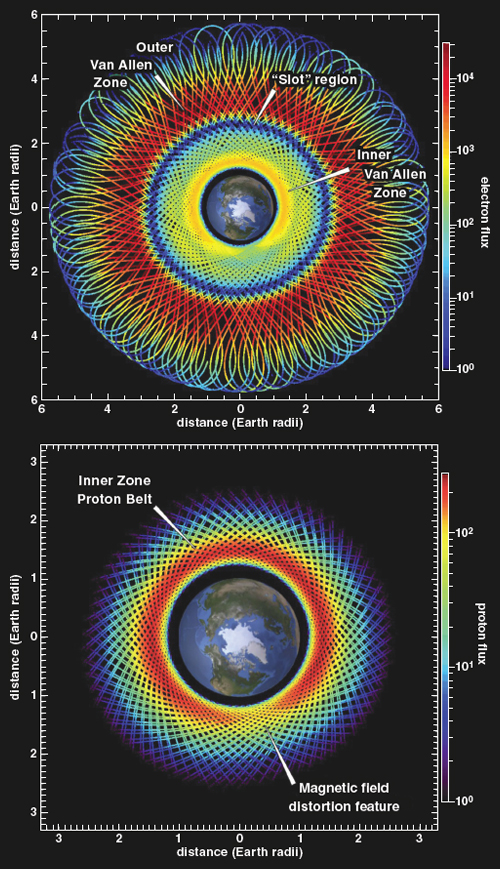
Illustration courtesy of the author.
It is challenging to describe measurements of the Van Allen belts in a graphically accessible way, so we are continually experimenting with new data visualizations (see the image above). One of our newest images shows the paths of the two Van Allen spacecraft as they move through the different zones of radiation. The satellites precess in elliptical orbits around the Earth, forming
a spiral pattern as seen from a fixed, Earth-centered coordinate system. Their data, measuring energetic electron and proton fluxes, are projected onto the geographical equatorial plane. The resulting orbital pattern looks much like a drawing created by a spirograph children’s toy, showing in the colored bands the weak inner Van Allen zone population of electrons, the slot region between belts, and the relatively stable (at least during this quiet six-week interval) outer Van Allen zone. Detailed features can be discerned in this display such as the relative paucity of inner zone energetic electron fluxes over the American sector; we believe this corresponds to the effect related to the Earth’s offset, tilted magnetic dipole.
Examining the color-coded flux profiles reveals that for the period shown (November 2 to December 15, 2012) the energetic electrons had the familiar, clear two-belt structure. The very high-energy protons, on the other hand, are seen only in the inner Van Allen zone and are confined to the region quite close to Earth. The proton data in this format clearly show the inner belt region and also show longitudinal asymmetries in particle fluxes associated with the Earth’s offset, tilted dipole magnetic field. This leads to an apparent reduction of particle fluxes over the American sector due to distortions in the Earth’s magnetic field.
The first two years of Van Allen Probes observations have demonstrated the immense benefits of near-equatorial dual-spacecraft measurements of highly relativistic electrons. Obtaining excellent temporal, spatial, and energy resolution has been key. When the solar wind is relatively calm (at speeds of about 300 to 600 kilometers per second) the outer radiation belt is characterized by slow, steady diffusive transport and gradual particle loss. However, the appearance of enhanced solar wind forcing, from transient coronal mass ejection drivers or high-speed solar wind (with velocities greater than 500 kilometers per second), quickly produced strong increases in particle energies and densities.

Illustration courtesy of the author.
The Van Allen Probes observations have illuminated the intimate relationship between external solar wind forcing and internal magnetospheric particle acceleration and transport by both solar wind streams and coronal mass ejection–driven geomagnetic storms. Data collected in March 2013 covered a particularly important interval to see how particle acceleration in the Earth’s radiation belt works (see image above). An event early in the month, associated with a high-speed solar wind stream, with a velocity greater than 650 kilometers per second, gave rise to a strong electron acceleration event that was centered at relatively large distances of five to six Earth radii, or about 35,000 kilometers. The population formed after the passage of the leading edge of the fast solar wind stream. For the next two weeks, our team observed that the core of the high-energy electron population diffused inward in radial distance, all the while exhibiting gradual diminution of magnetic fluxes, suggesting continual weak losses of particles.
The winding down of this long, diffusive acceleration event came to an abrupt end on March 17, 2013, when a strong interplanetary shock wave impacted Earth’s magnetosphere. As the shock passed, the solar wind speed jumped from about 425 to about 725 kilometers per second, and the solar wind magnetic field also showed very large changes. This event led first to extensive radiation belt depletion, but then to almost as rapid a reappearance of a seemingly new radiation belt population very deep in the outer belt. This new population was reminiscent of the October 2012 event.
Concurrent observations from the electric field and magnetometer experiments on board the Van Allen Probes spacecraft show that for both of these March 2013 events, the magnetospheric boundaries were forced deeply inward toward the Earth. Hence, we see that relativistic electron acceleration occurs when (and perhaps only when) the outer Van Allen zone is situated well outside its normal magnetospheric location. Only then can electromagnetic waves interact with much lower energy “seed” particles that are necessary for relativistic electron production. Our team is still exploring in greater depth the details of this acceleration process for March 2013 as it relates to the magnetospheric configuration and wave properties.
Even as the Van Allen Probes are allowing us to explore in detail the highly efficient particle accelerator operating around our planet, it also is leading to a better understanding of the equivalent processes taking place around other worlds. We can use the Earth’s radiation belt system as our most accessible local laboratory to study particle acceleration and transport mechanisms. We can then extend these lessons to the magnetospheres of other planets with strong magnetic fields, including Jupiter, Saturn, and Mercury (see figure below). In addition, we can now also extend the lessons of the Van Allen Probes to the thousands of planets being discovered around other stars. We can even apply these lessons to the extremely powerful magnetospheres of neutron stars—the collapsed remnants of supernova explosions—and, perhaps, to the magnetic fields that confine streamers of plasma on vastly larger, galactic scales.
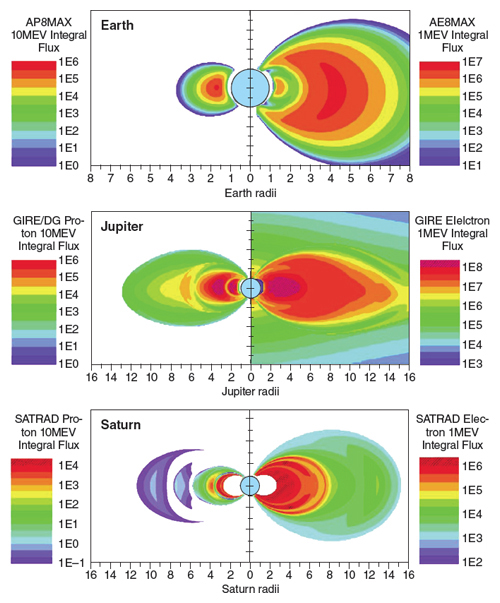
Adapted from an illustration by Henry Garrett, JPL.
In the 55 years since the launch of Explorer I, space scientists have made tremendous advances in their understanding of the magnetic and particle environment around the Earth. It is a fitting legacy to Van Allen and his pioneering discoveries that the Van Allen Probes continue to reveal new phenomena about this energetic and perilous region of space. Data from the Van Allen Probes, combined with readings from other satellites, are already being used to improve computer models that can incorporate real-time data of space activity and help forecast what’s happening in near-Earth space. When we look upon physical systems with new eyes—even those systems we think we know so well—we can make remarkable discoveries and gain amazing new insights. This possibility is a marvelous aspect of the endless frontier of space research.
Click "American Scientist" to access home page
American Scientist Comments and Discussion
To discuss our articles or comment on them, please share them and tag American Scientist on social media platforms. Here are links to our profiles on Twitter, Facebook, and LinkedIn.
If we re-share your post, we will moderate comments/discussion following our comments policy.